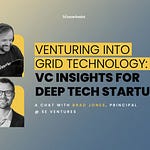Welcome to the 78th edition of Deep Tech Catalyst, the channel by The Scenarionist, where science meets venture!
If you're building in deep tech—and thinking about what it really takes to scale beyond venture—this follow-up is for you.
Today, we welcome back Jean Schmitt, Managing Partner at Jolt Capital!
In the first part of our conversation, we explored how private equity views deep tech: which metrics matter, why gross margins are key, and how the path to industrial scale is paved with operational discipline.
In this second part, we dive into the founder-facing realities of scaling advanced tech into real companies, where communication, IP, and cross-border execution separate momentum from noise.
We cover:
Why simplifying your message isn’t dumbing it down—it’s how you sell
How to turn IP into strategic leverage (and how not to)
What PE looks for in execution
The differences between scaling in the U.S. and navigating Europe’s fragmented markets
Why Europe has learned to fund startups—but still fails to finance their scale-up
If you're facing the leap from traction to scale, this conversation maps the questions that matter—and how investors on the other side of the table are thinking about them.
Let’s get into it. ⚙️
✨ For more, see Membership | Deep Tech Briefing | Insights | VC Guides
BEYOND THE CONVERSATION — REFLECTIONS & STRATEGIC INSIGHTS FROM THE EPISODE
Communicating Deep Tech: Clarity Over Complexity
For many Deep Tech entrepreneurs, the instinct is to showcase the complexity and sophistication of their innovation. However, as Jean Schmitt emphasizes, the ability to clearly and simply explain what the company does is the first and most critical filter for investment readiness.
Most investors are not domain experts. Even those with technical backgrounds are often trained in fields unrelated to the venture they are evaluating—synthetic biology is not semiconductor design, and AI modeling is not battery chemistry.
To attract capital, founders must be “generous” with their clarity. They need to bridge the knowledge gap by distilling their technology down to its essence: what it does, why it matters, and what makes it unique. This is not about dumbing things down. It's about respecting the audience and communicating effectively outside the echo chamber of technical jargon and acronyms.
Failure to do so is not just a communication issue—it’s a strategic red flag.
If a founder cannot explain the business in simple terms, investors will assume that the company won’t be able to sell its product either. Without broader comprehension, the only potential acquirers will be a handful of insiders, resulting in a low-value trade sale. In essence, clarity of message is directly tied to the perceived commercial potential of the company.
Simplicity in Explanation, Realism in Ambition
A two-million-euro company presenting billion-euro market forecasts sends the wrong signal. Overhyping potential does not impress seasoned investors—it undermines credibility.
Instead, founders should present a grounded vision, showing how they are building a real, sustainable business. Modesty and measured ambition are key. Investors are not looking for science projects with endless funding requirements, nor are they looking to support founders who feel entitled to capital simply because of the technical merit of their work.
What investors seek are entrepreneurial partners who view funding as a tool to build and scale a company, not as an end in itself. Founders must demonstrate that they understand their role as co-owners and stewards of capital.
Know Your Niche, Not Just the Global Trend
According to the guest, too often, founders anchor their pitch around the total addressable market for an entire industry, such as “the semiconductor market is worth X billions and growing at Y% annually.” While those statistics may be factually correct, they are rarely relevant to the precise corner of the market where the company operates.
What matters far more is a detailed understanding of the specific, narrow segment in which the product competes. If a company is building IP blocks for voice converters, the relevant market isn’t all of semiconductors—it’s the slice that pertains directly to that function. And in many cases, when investors drill into the actual market data, the real revenue generated by competing players in that niche adds up to something far smaller than founders expect.
This matters because scalability is often misunderstood.
If the only path to growth is through expanding into adjacent markets, then what’s being proposed isn’t a single business—it’s a series of smaller ones. That raises questions about coherence, focus, and efficiency. For Schmitt, that’s not a scalable company; it’s a fragmented strategy with unclear economics.
Founders often think that entering new markets one after another shows strong growth potential. But for investors, this strategy comes with significant risks.
Each new market requires validation, fresh customer relationships, possibly new regulatory approvals, and carefully adapted go-to-market strategies. If the core market isn't large or accessible enough, what may appear to be growth starts looking like a lack of focus. From an investor’s perspective, this type of sequential expansion is often seen not as an opportunity but as a risk.
Business plans that depend on massive upfront investments, such as needing €100 million just to reach first revenue, raise immediate concerns. While this approach might be justified in the context of public R&D programs or corporate innovation budgets, it signals a misunderstanding of capital efficiency when applied to privately funded ventures.
What investors want to see is a clear, disciplined view of the market opportunity—not just a grasp of the technology, but a solid understanding of how to turn it into a viable, scalable business.
Intellectual Property as a Strategic Asset
A patent creates the breathing room necessary to build a business by granting exclusive rights to operate in a given territory for a defined period. Without it, even the most brilliant invention is vulnerable to replication or legal challenge. We've heard this from VC investors, and the same holds true for PE.
“The patent is for me a localized monopoly in time and space.”
Schmitt is unequivocal: coming to an investor and declaring that you have no patents because you are “protecting trade secrets” is a major misstep. No serious investor will take comfort in secrecy alone.
The reality is that no one discloses their entire invention in a patent, nor are they expected to. Strategic omission of certain details is standard practice. The key is to file patents that protect meaningful aspects of the invention while retaining enough proprietary know-how to maintain a lead.
Just as importantly, companies need a clear patenting strategy. For instance:
Are they filing for offensive reasons—to stake out territory and discourage competition—or defensive ones—to shield themselves from encroachment?
Have they conducted a proper freedom-to-operate analysis?
Are they aware of existing patents in their domain?
These are not due diligence items to be handled reactively; they are indicators of a founder’s mindset and maturity.
“So, for example, you have a competitor […] And they are about to raise a large amount of money, which will probably create a lot of trouble for you. You know, if they infringe a little bit—some patents—you can send a letter, a registered letter with your lawyer, saying that, you know, by looking at what they do and by looking at the product, you think that they might infringe your IP. The company is sterilized. The investors who are looking at that firm are all going to hold their hands and say, «Nah, we cannot touch this thing.» It's becoming toxic. Not very nice—very effective. It happened to us already, to get this type of letter. We had a letter on the day of the IPO of a company. That letter was totally frivolous. But the bankers decided not to take the company public, and we lost one year before we could go public again.”
The Mindset Behind Strong IP Strategy
In capital-intensive sectors like semiconductors, where physical assets may be limited, IP is often the only true asset on the balance sheet. But to do that effectively, founders must approach IP not as a box to check, but as a living, dynamic asset that evolves with the business.
“You can trade IP, you can sell it, you can share it, you can pool it.”
So, PE investors look at how founders think about them.
Do they understand that IP is their most valuable asset?
Are they prepared to use it strategically, both to protect and to negotiate?
Testing for Ability vs. Verifying Execution
Jean Schmitt draws a sharp line between how venture capital (VC) and private equity (PE) investors approach due diligence, and it starts with the core question each type of investor is trying to answer.
In Venture Capital, the Question Is: “Can They Do It?”
At this stage, there’s limited data and very little track record. The emphasis is on assessing potential—whether the team has the ability to build a product, sell it, and grow the business. For a VC, due diligence involves testing. That might mean introducing the startup to a potential customer to see how the team pitches. It might involve probing their assumptions or reviewing the founding team’s past ventures.
Much of the process revolves around people.
Are the founders adaptable?
Do they have the willingness to learn, especially in domains outside their core scientific expertise?
This is especially critical when the founders come from academia or research backgrounds. In Schmitt’s experience, scientists often enter business thinking they know everything, only to discover that commercial success requires humility, openness, and discipline. Investors must test for coachability and the ability to grow into the role of business leader, not just a technologist.
In Private Equity, the Question Is: “Did They Do It Right?”
In other words, private equity is not betting on potential; it’s evaluating outcomes. When a PE investor enters, the business has already been operating for some time. The focus is on performance, structure, and readiness to scale.
This shift transforms how companies are evaluated.
At the PE stage, investors look at specific metrics and operational KPIs:
If it’s a semiconductor company, what is your gross margin?
If it’s under 45%, that’s a red flag, possibly indicating that the technology has limited value or that the cost structure is broken.
What’s your inventory turn? A low turn rate suggests future obsolescence and costly write-offs.
Are you redeveloping your chip architecture and geometry at the same time? That’s a sign of technical mismanagement—no serious operation does both simultaneously.
Every operational detail matters. Other smart questions could be:
Who are your subcontractors?
What testing tools are you using?
How do you manage your supply chain?
How do you protect your IP?
“There is a generic rule, which comes from Piero Martinotti. He was the head of innovation at ST. […] Piero had a rule which I never forgot, which is: «$1 million in R&D, I want a patent.» So, $1 million in R&D equals one patent. And it works in any company. I use it all the time.”
Scaling in Europe vs. the US: Strengths, Constraints, and Opportunities
One of Jean Schmitt’s most pointed observations is aimed at European entrepreneurs who try to emulate Silicon Valley too closely. And that’s not just a statement of geography—it’s a recognition that Europe operates within a fundamentally different environment, with different advantages and constraints.
In the U.S., companies benefit from a massive, unified domestic market, standardized legal frameworks, and an investor base that has historically embraced high-risk, high-growth innovation. Engineers are expensive, but capital is abundant. Sales forces can scale nationally without crossing borders. For many American startups, early success is often found within a few hundred miles of their headquarters.
Europe, by contrast, is fragmented—culturally, linguistically, and commercially. The continent lacks a unified market in practice, even if it exists on paper. These divisions complicate everything from sales expansion to regulatory compliance, especially for companies hoping to scale across borders.
Europe’s Fragmentation and Its Global Silver Lining
Despite the challenges of a fragmented internal market, European Deep Tech companies benefit from lower operational costs, high-quality research institutions, and a culture that is often more internationally minded.
From day one, European startups must look beyond their borders to grow. This early global orientation, Schmitt argues, can be a strength, particularly in sectors like semiconductors, advanced manufacturing, or AI, where customers are truly international.
Moreover, Europe produces world-class research at a fraction of the cost seen in the U.S. This gives deep tech founders the ability to design and develop novel technologies with high intellectual value but lower capital intensity. If paired with strong IP and commercialization strategies, these conditions can produce globally competitive companies.
However, European companies must accept that their path to market will never be as smooth as their American counterparts. They must be prepared to travel, to sell internationally, and to navigate complexity early on. The advantage of lower R&D costs must be matched with operational maturity and strategic focus.
Moreover, when it comes to scaling deep tech, Schmitt identifies one structural weakness that towers above the rest: the absence of European pension funds as active participants in innovation financing.
While sovereign wealth funds in Europe have become increasingly active, they are not sufficient on their own.
Schmitt argues that the real birth of Silicon Valley was not a result of Stanford geniuses alone—it was the moment pension funds in the U.S. began allocating capital to high-risk venture funds. This unleashed the formation of legendary firms like Kleiner Perkins and Sequoia, which in turn backed Apple, Cisco, Microsoft, and others. These returns not only funded the retirement of millions of Americans but also seeded an entire generation of high-growth technology.
Europe’s innovators need a functioning capital system that understands risk and rewards long-term value creation. Until pension funds step into that role, Europe will remain at a structural disadvantage, regardless of how talented its scientists or how brilliant its engineers may be.
Bridging the Growth Capital Gap: From €20 Million in Revenue to €200 Million
Over the past decade, Europe has made real progress in supporting early-stage innovation. Jean Schmitt acknowledges that countries like France, Germany, Italy, and others—alongside regions like Canada, Korea, and Japan—have all increased their venture capital allocations significantly. In fact, when measured against GDP, Europe has now overtaken the U.S. in venture capital deployment at the seed and early growth stages.
That’s a meaningful achievement, and it reflects a growing understanding of how to support startups in the formative phases of their development.
But Schmitt is quick to point out that this success hides a deeper, unresolved issue. While Europe has learned to fund the beginning of the journey, it still fails to fund what comes next. Growth capital, the kind that supports scale-up and industrial expansion, remains dramatically underdeveloped. And the gap between Europe and the U.S. in this area is not shrinking—it’s growing.
U.S. growth capital investment has been “explosive,” Schmitt notes. Europe’s, by contrast, has barely budged. That leaves promising companies stranded. “We are going to lose a lot of startups,” he warns. Not just the weak ones, which, in some sense, the market can afford to lose, but strong, well-run companies with real potential that simply lack access to the multi-stage funding needed to go from €20 million in revenue to €200 million.
Growth capital is the lever that turns technical promise into industrial strength. It funds new factories, global sales organizations, supply chain infrastructure, and the hiring of senior commercial talent. Without it, scale is impossible. With it, companies can build the kind of strategic depth that makes them real players on the world stage.
For Schmitt, this isn't just about raising larger rounds. It’s about building a financial ecosystem in Europe that can support bold industrial ambitions. And that means going beyond early-stage VCs and public subsidies. It means serious, risk-aware private capital with long-term vision—and a deep understanding of what it takes to grow.
AI-Powered Electronics Labs in the Cloud
Four Startups, One Rumor. A new wave of platforms is virtualizing the electronics lab — from firmware to fabrication.














